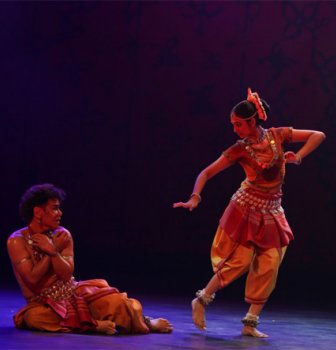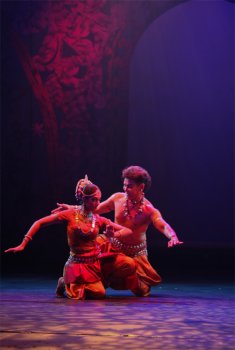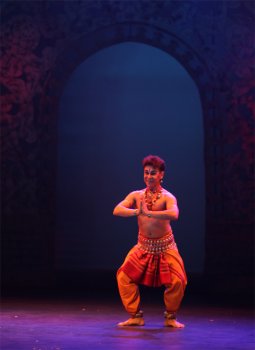
|   |

|   |
Sophisticated evolution of Sutrarasa - Dr. Sunil Kothari e-mail: sunilkothari1933@gmail.com Photos courtesy: Sutra September 21, 2012 When Ramli Ibrahim started studying Odissi under Guru Deba Prasad Das, he was introduced to the basic grammar of Odissi, which he had to master like all disciples. However, besides Odissi dance technique, Ramli had already received training in classical ballet and modern dance when he was performing in the company of Graeme Murphy for the Sydney Dance Company, Sydney Opera House in the mid seventies. Versatile and trained in a different dance vocabulary, Ramli with great tenacity and determination mastered and absorbed the techniques of classical Indian dance forms like Bharatanatyam and Odissi. And this fund of knowledge has stood him in good stead giving him freedom to express himself with greater sensitivity and imagination. Presenting Sutrarasa during Tarikan Dance Festival 2012 at Panggung Eksperimen Theatre, University of Malaya, at Kuala Lumpur on 5th and 6th September, conceptualized as a duet with eighteen year young Geethika Sree, Ramli took the audience through the evolution of Sutra Dance Theatreís repertoire comprising of classic works of Guru Deba Prasad Das and those commissioned to the latterís major disciple, Guru Gajendra Kumar Panda. This initial development eventually led to the formation of Sutraís distinctive Odissi. It was interesting for me to go through this journey, witnessing the performances and I began to notice so many facets of Deba Prasad Dasís style. There were indeed few occasions to see Guru Deba Prasad Dasís disciples in Odissi performances as Guru Kelucharan Mohapatraís disciples, a legion, dominated the scene. Ramliís performances brought attention to Deba Prasadís style. It was interesting to watch the choreographic works of Deba Prasad as performed by Ramli with his sophisticated approach, the rearrangement of those numbers with his well trained dancers in Kuala Lumpur, be they Malay, immigrant Indian Diaspora, half Malay, half Chinese, both boys and girls, performing to traditional Odissi music. Beginning with Mangalacharan, an invocatory dance with a verse dedicated to Lord Shiva in Sanskrit describing Ganga flowing from his matted locks, both Ramli and Geethika enter the stage with flowers, and cover the stage lit up by Shivarajah Natarajan, in a typical walk coming forward to the front of the stage and joyously throwing flowers into the audience, succeeding in creating impressive visuals. 

The Saveri Pallavi set to raga Saveri performed as a duet by Ramli and Geethika is a tour de force. The raga Saveri is personified as a Sabari woman, a huntress, dwelling in the forest, surrounded by mountain peaks, where peacocks strut. She is adorned with snakes for bangles and ornaments, is imagined as enticing unsuspecting prey. Ramli has interpreted it alluding to the image of Nijinsky, who dancing as a slave, is unsuspectingly enchanted by Saveri, with her serpentine movements, following her, trying to imitate her movements. Saveriís dancing with serpentine movements, merging with pure dance movements of pallavi, sculpturesque, broad and sweeping, attracts the male who dances with joy. This tension and interaction between female and male dancers becomes increasingly delectable with progression to the music, to the beats of the pakhavaj and at times perfectly synchronized passages and at times the confused attempts of the male. The ending is innovative and leaves an impact with images of the male being stung several times by Saveri almost turning into a serpent, the male falling on the floor, rolling on his stomach, Saveri riding on his back, facing sky upwards, waving arms and fingers with hypnotic movements, lights fading creating a silhouette. No wonder the audience burst forth into thunderous applause. Geethika enacted abhinaya set to Banamaliís Odiya song Mohane deli chahi, dwelling on Radha or a Gopiís state of enchantment listening to Krishnaís divine flute, set to raga Kirvani. Ramli has re-choreographed in an interesting manner, layering the song though enacted by one dancer, as if not one but many Gopis were in that state as was Radha when Radha confided to the sakhi the mesmerizing tunes of the flute. Geethika performed it with youthful charm, becoming the state of the young Gopi/Radha.  Ramli Ibrahim  Geethika Sree Navarasa number saw Ramli and Geethika individually and together displaying the various moods. Sringaram saw Geethika elaborating upon Sitaís appearance, moving in a garden, showing a pair of birds making love, lotus and a bee, the similes suggestive of mood of union of lovers. Ramli in veera rasa was Rama, lifting the bow, Geethika displayed the karuna rasa, compassion. The episode is as follows: When in the forest, Rama was sleeping with his head on the lap of Sita, a demon in form of a crow, attacks Sita on her breast. The blood flows and touches Rama who wakes up and in a moment realizes what caused the blood to flow. He looks at the demon in crow form, and burns him with his powerful look. Sita felt compassion for the demon who was overcome by lust at her beauty and died. In the Ramayana sloka Karunyam Bali bhojane, the depiction of compassion is shown by the dancer stroking the bird. The story remains unclear. Ramli and Geethika delineated hasyam (laughter) and bhayam (fear) without the rendering of sahitya (the text) and it looked equally interesting with their expressions which were not only facial, mukhajabhinaya, but also angikabhinaya, through the entire frames. Bibhatsam was treated as disgusting smell, raudram with two palms and finger nails of Rama, which Ravana saw and knew his end was near. Shantam, equipoise, was enacted with folding of arms in obeisance. The most captivating duet was Ardhanarishwara, using the Sanskrit texts including Sankaracharyaís describing Parvatiís female form adorned with champaka flower, Shivaís with ashes et al, but had additional verses and sabdaswarapata, the salient feature of Deba Prasad Das style. These are excellent verses rendered as recitation, like kavits in Kathak and have enchanting texture. The description of tandava, the refrain Namah Shivaya all come to a crescendo and the dual forms of Shiva and Parvati as Kalidasa describes, shbadrathu iva samyuktau Parvatiparameswarau - as are united the word and the meaning, so are united Parvati and Shiva. Deba Prasad Das had a penchant for such numbers enriching it with many elements. When the lights fade out and audience claps, Ramli and Geethika enter stage again dancing Moksha, covering the stage, with beats of pakahavaj in fast tempo. I liked this ending which puts audience in a happy frame of mind as the dance recital concludes. In contrast to Ardhanarishwara unfolding, Moksha unfolds joyously and audience stands up giving exulted ovation! It was a sheer pleasure to watch Sutrarasa which has the distinct signature of Ramli as a choreographer, retaining the Deba Prasad style intact and decorating it with flourishes which enhances its impact. To watch Ramli in full command of his physical prowess along with young Geethika Sree speaks volumes for Ramliís stage presence and dignity of a senior artiste, never once overshadowing the young dancer. Dr. Sunil Kothari is a dance historian, scholar, author and a renowned dance critic. He is Vice President of World Dance Alliance Asia Pacific India chapter, based in New Delhi. He is honored by the President of India with Padma Shri, Sangeet Natak Akademi award and Senior Critic Award from Dance Critics Association, NYC. He is a regular contributor to www.narthaki.com, the roving critic for monthly magazine Sruti and is a contributing editor of Nartanam for the past 11 years. |